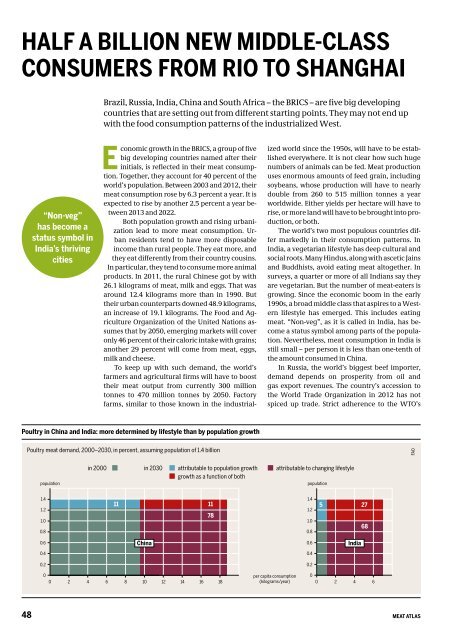1jjtwKx
1jjtwKx
1jjtwKx
Create successful ePaper yourself
Turn your PDF publications into a flip-book with our unique Google optimized e-Paper software.
HALF A BILLION NEW MIDDLE-CLASSCONSUMERS FROM RIO TO SHANGHAIBrazil, Russia, India, China and South Africa – the BRICS – are five big developingcountries that are setting out from different starting points. They may not end upwith the food consumption patterns of the industrialized West.“Non-veg”has become astatus symbol inIndia’s thrivingcitiesEconomic growth in the BRICS, a group of fivebig developing countries named after theirinitials, is reflected in their meat consumption.Together, they account for 40 percent of theworld’s population. Between 2003 and 2012, theirmeat consumption rose by 6.3 percent a year. It isexpected to rise by another 2.5 percent a year between2013 and 2022.Both population growth and rising urbanizationlead to more meat consumption. Urbanresidents tend to have more disposableincome than rural people. They eat more, andthey eat differently from their country cousins.In particular, they tend to consume more animalproducts. In 2011, the rural Chinese got by with26.1 kilograms of meat, milk and eggs. That wasaround 12.4 kilograms more than in 1990. Buttheir urban counterparts downed 48.9 kilograms,an increase of 19.1 kilograms. The Food and AgricultureOrganization of the United Nations assumesthat by 2050, emerging markets will coveronly 46 percent of their caloric intake with grains;another 29 percent will come from meat, eggs,milk and cheese.To keep up with such demand, the world’sfarmers and agricultural firms will have to boosttheir meat output from currently 300 milliontonnes to 470 million tonnes by 2050. Factoryfarms, similar to those known in the industrializedworld since the 1950s, will have to be establishedeverywhere. It is not clear how such hugenumbers of animals can be fed. Meat productionuses enormous amounts of feed grain, includingsoybeans, whose production will have to nearlydouble from 260 to 515 million tonnes a yearworldwide. Either yields per hectare will have torise, or more land will have to be brought into production,or both.The world’s two most populous countries differmarkedly in their consumption patterns. InIndia, a vegetarian lifestyle has deep cultural andsocial roots. Many Hindus, along with ascetic Jainsand Buddhists, avoid eating meat altogether. Insurveys, a quarter or more of all Indians say theyare vegetarian. But the number of meat-eaters isgrowing. Since the economic boom in the early1990s, a broad middle class that aspires to a Westernlifestyle has emerged. This includes eatingmeat. “Non-veg”, as it is called in India, has becomea status symbol among parts of the population.Nevertheless, meat consumption in India isstill small – per person it is less than one-tenth ofthe amount consumed in China.In Russia, the world’s biggest beef importer,demand depends on prosperity from oil andgas export revenues. The country’s accession tothe World Trade Organization in 2012 has notspiced up trade. Strict adherence to the WTO’sPoultry in China and India: more determined by lifestyle than by population growthPoultry meat demand, 2000–2030, in percent, assuming population of 1.4 billionFAOpopulationin 2000 in 2030 attributable to population growthgrowth as a function of bothattributable to changing lifestylepopulation1.41.21.00.811 11781.41.21.00.8527680.6China0.6India0.40.40.20.200 2 4 6 8 10 12 14 16 18per capita consumption(kilograms/year)00 2 4 648MEAT ATLAS


